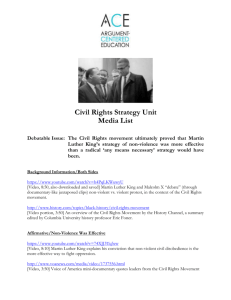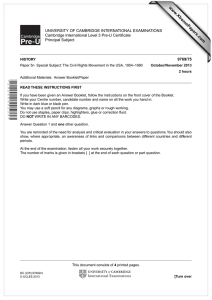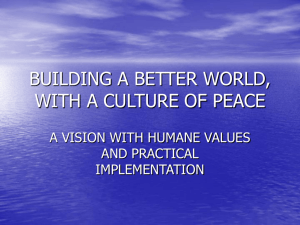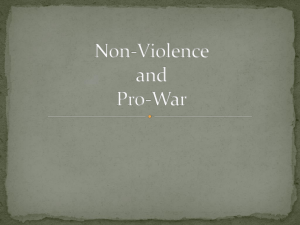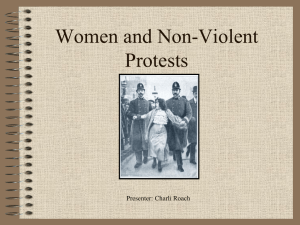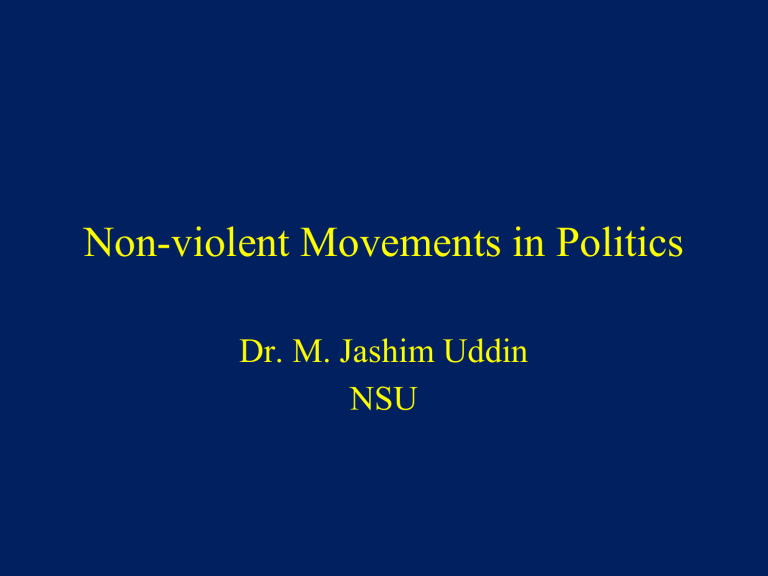
Non-violent Movements in Politics Dr. M. Jashim Uddin NSU Summary ❑ Millions of people have been killed in violent conflicts in the world. Since the WWII, there have been on average about 30 armed conflicts ongoing every year. According to a source, 90% of casualties in these conflicts have been civilians. ❑ Various methods have been applied to resolve the conflicts. But, question is how many of them have been successful to resolve and root out the seeds of conflict? ❑ Ongoing conflicts/wars are the evidences that peaceful resolutions are not easy, and people including innocent women and children are continuously dying there; Violence leads to more violence. Summary ❑ Scholars argued that non-violent movement is a significant method in reducing violent conflicts and making the world more peaceful. ❑ What is non-violent movement? ❑ It is a peaceful method which clearly denies any conflict to occur to gain one’s interests and goals. It is a philosophy as well as a technique that rejects the use of physical violence. ❑ Practice of non-violence a culture of peace in a society. ❑ Why should non-violence be given priority and what lessons can be learnt from such movements? Conceptual Analysis of Non-violence ❑ Conflicts are seen in different forms for example, between religious/ethnic majority and minority, repressive ruler and subject, government and opposition etc. “Conflict is an inseparable part of all human social relations.” – Edward Azar Non-violence from Religious Perspectives: ❑ The major religions teach non-violence, e.g., forgiveness, e.g., Imam Zayn el-Abidin is quoted as saying: “On the Day of Judgment, Allah the Almighty assembles all the people in one location and then it is announced, “Where are the noble people?” A group of people rise, who are then asked, “What distinguishes you from the rest?” ❑ In reply they say: “We used to make bonds with he who broke off with us, we used to give to he who deprived us, we used to forgive he who used to oppress us.” They are then told; “You have said the truth, so enter the heaven.” Conceptual Analysis of Non-violence ❑ Prophet of Islam many times beg and cry to Almighty to forgive his enemy who persecuted him. ❑ Jesus said that ‘love thine enemy’. ❑ Sage Vyasa defines Ahimsa as "the absence of injuriousness toward all living beings (sarvabhuta) in all respects (sarvatha) and for all times (sarvada)." ❑ Lord Buddha said enmity cannot be appeased by enmity. Conceptual Analysis of Non-violence ❑ Conflict of interests between two people/groups is as old as the civilization itself. But, where a society is rooted in principles of nonviolence, resolving conflict at its incipient stage and controlling it in its escalated stage becomes easier. ❑ Nonviolence is a technique, denies the use of violence to secure one’s interests and rights. Its methods may include persuasion, peaceful campaigns, boycotts, strike, civil disobedience, purposeful agitation and so on. Conceptual Analysis of Non-violence ❑ Many political scientists think that opposition movements select violent methods as they are more effective than non-violent strategies at achieving policy goals. ❑ Despite the view, it is found that from 2000 to 2006, organized civilian populations successfully employed non-violent methods to challenge authoritarian/undemocratic regimes in many countries. ❑ Non-violent students movement against discriminatory quotas in government service in Bangladesh in April 2018; outcomes Definitions of Non-violence • Gandhi noted that “Non-violent resistance implies the very opposite of weakness. Defiance combined with non-retaliatory acceptance of repression from one's opponents is active, not passive.” • It requires strength for using non-violent methods in political struggle and the quest for Truth. • Wally Nelson argued that “Nonviolence is the constant awareness of the dignity and the humanity of oneself and others; it seeks truth and justice; it renounces violence both in method and in attitude; It is the willingness to undergo suffering rather than inflict it. It excludes retaliation.” Definitions of Non-violence • Dr. Martin Luther King noted that nonviolence has some basic elements: • 1) nonviolence is a resistance to evil and oppression; • 2) it does not seek to defeat or humiliate the opponent, but to win her/his understanding; • 3) the non-violent method is an attack on the forces of evil rather than against persons doing the evil; • 4) it is the willingness to accept suffering without retaliation; • 5) it avoids both external physical and internal spiritual violence not only refuses to shoot, but also to hate an opponent. Principles of Non-violence ❑ The fundamental principles/bases of non-violence are Ahimsa, truth, love for the enemy and God’s creation, compassion, tolerance, forgiveness, justice etc. ❑ Ahimsa as Gandhi believed is the most effective principle for social action. Himsa (violence) corrupts man, whereas Ahimsa heals man's nature to restore justice. ❑ Similarly, Truth is one of the essence of non-violence. Those who have adopted non-violence should not base their demands or movements on falsehood or injustice, they should hold on what is rightful, equal and just. Principles of Non-violence ❑ Love for the enemy and God’s creation is significant principle of non-violence. Jesus said that ‘love thine enemy’, establishing mutual harmony in a society. ❑ Regarding this, a Turkish scholar Nursi argues that in the Quranic words, all humans are the supreme creations of God; the simple but fundamental fact is that they are created by God and thus possess a sacred nature, which does not permit any violence against humans, not even those who deny God. ❑ Violence against humans would ultimately mean a denial and rejection of God's beautiful art. Principles of Non-violence ❑ Forgiveness is a supreme virtue essential for those following non-violence. Tolerance and compassion are the qualities without which a non-violent movement can’t be sustained and will become violent. ❑ Another crucial element of non-violence as advocated by Nursi is Justice: he mentioned the recurring Qur’anic verse: “No soul shall bear the burden of another soul.” ❑ Nursi gave an example: if there are nine passengers on a ship who committed serious crimes and one innocent person, this would not justify burning or sinking the ship. Nursi closed the doors particularly for militant who unleash violence against innocent civilians. Non-violent Movements in South Asia: Case of Ghaffar Khan ❑ Khan Abdul Ghaffar Khan was a Pashtun political and spiritual leader. He is known as “Frontier Gandhi” and raised history’s first “non-violent army” of 100,000 men, who through non-violent means stood up unarmed against injustice. ❑ Having witnessed the repeated failure of revolts against the British Raj, he was convinced that the armed resistance would not bring solution and established the Khudai Khidmatgar (KK) Movement. ❑ Ghaffar Khan told its members: “I am going to give you such a weapon that the police and the army will not be able to stand against it. It is the weapon of the Prophet, but you are not aware of it. That weapon is patience and righteousness. No power on earth can stand against it.” The case of Ghaffar Khan ❑ The British Indian government made extensive propaganda against the Khudai Khidmatgars, and tried to equate them with the Bolsheviks. ❑ The volunteers of KK were taught not to resort to violence and also not to carry weapons. More emphasis was given upon the forbearance. ❑ They were reminded of the atrocities of Makkans over Muslims during the initial days of Islam and how Holy Prophet and his Companions faced it with forbearance. After the conquest of Makkah, the Muslims could have taken revenge but followed the true path of non-violence. Non-violent Movements in South Asia: The case of Ghaffar Khan ❑ Ghaffar Khan also emphasized the communal harmony in the province. Therefore, the membership was kept open to all, irrespective of any discrimination of caste, community or religion. ❑ The movement’s success triggered a harsh crackdown against him and his supporters. In the late 1920’s that he formed an alliance with Gandhi and the Indian National Congress. On several occasions when the Congress seemed to disagree with Gandhi on policy, Ghaffar Khan remained Gandhi’s ally. ❑ In 1931 the Congress offered him the presidency of the party, but he refused. The Case of Ghaffar Khan ❑ On April 23, 1930, Ghaffar Khan was arrested during protests arising out of the Salt Satyagraha; through a series of laws, the Indians were prohibited from producing salt independently. British also introduced taxation on salt production. ❑ This movement sparked a large scale of civil disobedience in the Indian subcontinent. The Case of Ghaffar Khan Gandhi gives the last instructions on the beach near Dandi, India, as he and his supporters get ready to demonstrate at the Salt Satyagraha (Salt March) in which they marched 241 miles to the sea to make their own salt, April 6, 1930. Britain responded by arresting over 60,000 people. Photo by W. Bossard/Associated Press. The Case of Ghaffar Khan ❑ A crowd of KK gathered in Peshawar's Kissa Khwani Bazaar. The British ordered troops to open fire with machine guns on the unarmed crowd, killing an estimated 200-250. The KK members acted in accord with their training in non-violence under Ghaffar Khan, facing bullets as the troops fired on them. ❑ Throughout his life, he never lost faith in his non-violent methods. Ghafar Khan spent 52 years of his life imprisoned or in exile. Ghaffar Khan with Gandhiji Badsha Khan and Gandhiji in a Public meeting in Peshawar Lesson’s Learnt ❑ The non-violent movements led by Gandhi and Ghaffar Khan against the British colonial master were remarkable to remind the world that violence is not the only way to resolve a conflict. ❑ Peaceful techniques can also be useful to establish one’s fundamental rights if they are based on truth. ❑ Both Mahatma Gandhi and Ghaffar Khan showed the world how unarmed people can fight against a powerful enemy for their basic rights. Tolerance, compassion and love for God’s creature are the weapons used in these struggles. Lesson’s Learnt ❑ Peaceful movements against the British Raj to quit India received attention to build opinion against colonialism and racism worldwide. ❑ Dr. King and Nelson Mandela took lessons from the non-violent methods applied in South Asia to uphold their civil rights movements against racism. ❑ Teaching of Non-violence can help establish a culture of peace in society.
